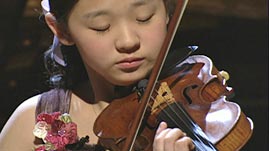Teachers' Domain - Digital Media for the Classroom and Professional Development
User: Preview


Source: From the Top at Carnegie Hall: "Rythym and Strings"
You can see the full episode and a more complete lesson plan at the From the Top at Carnegie Hall Web site.



Exclusive corporate funding provided by Liberty Mutual. Additional funding provided by the Bernard Osher Foundation, the Jack Kent Cooke Foundation, the National Endowment for the Arts, Helen and Peter Bing, and the E.H.A. Foundation.
In this performance video segment from From the Top at Carnegie Hall, Anna JiEun Lee plays a virtuosic piece for violin by Pablo de Sarasate called Zigeunerweisen (Gypsy Airs), accompanied by pianist Christopher O'Riley. Listen for elements that are quick and dance-like, and others that are slow and mournful, as well as harmonies reminiscent of folk music. The music of the gypsies of Eastern Europe was the inspiration for the piece.
In the supplemental video segment, Anna describes why music is so important to her and how she began studying the violin. She also talks about her family and what her friends think of her passion for music (they support it) and of classical music in general (they hate it).
Gypsy Airs: Anna JiEun Lee Profile (Video)
Pablo de Sarasate was a 19th century Spanish violinist and composer. Like Anna Lee, he began violin lessons as a small child and was admitted to a famous conservatory by the time he was 12. Like many composers of his era, de Sarasate was influenced by folk and ethnic music while looking for ways to make music more expressive and freer from the conventions of the Baroque and classical periods.
The form of Gypsy Airs is based on a traditional Hungarian dance called czardas, which was used in recruiting soldiers. It begins with a slow section and is followed by very fast, wild sections in 2/4 time. This piece is very demanding technically, with extremely fast passages, slow and sensitive sections, and lots of challenging fingering and bowing techniques. Other composers who used this form were Franz Liszt, Bela Bartok, and Zoltan Kodaly. It's not hard to imagine soldiers whirling madly to the sound of a violin.
A note about Gypsies: the word is used today to refer to many different and distinct groups whose ancestors migrated eastward from northern India into central Asia and Eastern Europe around 1000 CE. Also known as Roma (and by other names in different countries where they settled), Gypsies share many cultural traits, as well as languages that began in common Indo-Aryan roots. Like many minority groups, they were discriminated against, and even enslaved, after their migration. Music is one of the hallmarks of traditional Roma culture and retains its special character even when influenced by the music of the dominant population. In particular, because many Roma preferred occupations that allowed them to be independent and work alongside family members, there have been professional musicians among the Roma for centuries.
There is also a special scale associated with gypsy music, which is similar to the minor scales we associate with Western classical music. It has a haunting, melancholy quality that is often found in Eastern European folk music. The gypsy scale consists of c, d, e flat, f sharp, g, a flat, b, and c'.
To read a story about Anna and listen to her perform another Sarasate piece on From the Top's radio program, check out From the Top.
To hear a review of Gypsy Caravan, a 2006 documentary by filmmaker Jasmine Dellal about a touring group of Gypsy musicians from India and Europe, check out Documentary Chronicles Gypsy Music on National Public Radio.
 Loading Standards
Loading Standards